January 27, 2018
Our topic was “Old Hay Bay Church and Its People” presented by Kathy Staples. Kathy Staples has a long history with Lennox & Addington County historic landmarks. This began with her role as Chair of Adolphustown’s Bicentennial celebrations in 1984. She worked at the Adolphustown UEL Museum for more than a decade before getting involved with the restoration and promotion of the Old Hay Bay Church, built in 1792.
Kathy spoke briefly about the meetinghouse itself, since most present had at least some knowledge of the building. It’s the oldest Methodist Meeting House in Canada. William Losee, the first saddlebag preacher who served the area, led meetings in houses until 1792, by which time the assemblies had outgrown the log cabins where they were meeting. In 1792 Loyalist Paul Huff donated a portion of his land, and 22 subscribers contributed 127 “Halifax currency” (approx.1 Pound = 4 dollars) to erect a building. It was enlarged in 1835. In 1860 the building was sold and used as a barn until 1911, when a group bought it back, renovated it and had it dedicated once again as a church. On the fourth Sunday of August the Annual Pilgrimage Service is held. This year on August 26th they will commemorate the 200th anniversary of Paul Huff’s death.
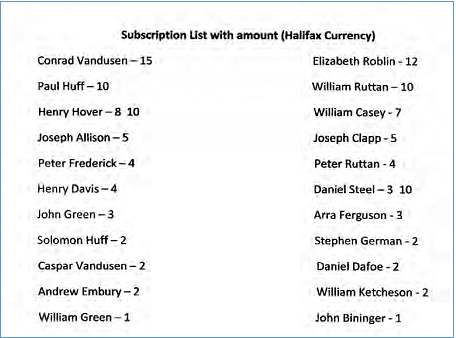
List provided by Kathy Staples.
Kathy spoke about the 1984 celebrations at Adolphustown and activities since, such as a large “Roots 2016” reunion held at Hay Bay. Over the years the church has been rented for weddings and other events, and occasionally other churches ask permission to hold special services there. In 2003 a movie, “Discovering Emma” was filmed there. All these rentals provide funding towards the maintenance of the building.
In 2015, CNN decided to explore the ancestry of its anchors, and found that Jake Tapper is a descendant of Solomon Huff (who is technically not a Loyalist, having been removed from the “Loyalist List” in the nineteenth century, but was brother of Paul Huff and one of the original subscribers). They arranged for Mr. Tapper and a film crew to visit Hay Bay Church, and Kathy Staples arranged for him to visit the church and graveyard etc. and to meet some distant cousins (including Peter Johnson, co-Dominion Genealogist). It was not a successful visit: Tapper kept saying how embarrassed he was to find out he had “traitorous Tories” in his Ancestry – completely ignoring the fact that his mother was born in Winnipeg, making him half-Canadian.
Kathy spoke about some offbeat groups and individuals who have also had an interest in visiting the church. The Correctional Officers Paranormal Society (COPS) have visited the site. Dowsers have come to dowse for graves, and found some around the church and under the 1835 addition that had not been previously known. Psychics have visited, drawn – they said – by the church’s aura. And then Kathy told us about an experience last August.
Despite the unhappy experience of Jake Tapper and CNN’s visit, the trustees agreed to allow a film crew and cast from a program “The Other Side” to visit. The program runs on APTN, the Aboriginal Peoples’ Television Network. Without giving all the details – you’ll want to catch the program in Fall 2018 – Kathy is convinced that the staff did have contact with the “energy” or “spirit” of Catherine German, mother of two of the children drowned on August 29, 1819. A leaky boat containing 18 people, mostly children, was crossing the water to attend church when it sank. Eight were rescued, but ten children died.
Kathy invited all to visit the Old Hay Bay Church, which is open, this year, daily from May 19th to Thanksgiving; and especially to visit on August 26th for the Pilgrimage Service. She also mentioned that the church has embarked on a three-year campaign to raise $300,000 to do the necessary repairs of the church, cottage, cemetery and grounds in an appropriate heritage maintenance project. The first priority is to replace the clad siding and window casements of the church. Donations are welcome: charitable tax receipts are issued for donations over twenty dollars. You can donate by sending a cheque, made payable to: Old Hay Bay Church, c/o K. Staples, 1105 – 828 Sutton Mills Ct., Kingston, ON K7P 2S9 or you can donate online through the website http://www.oldhaybaychurch.ca/
Saturday, March 24, 2018
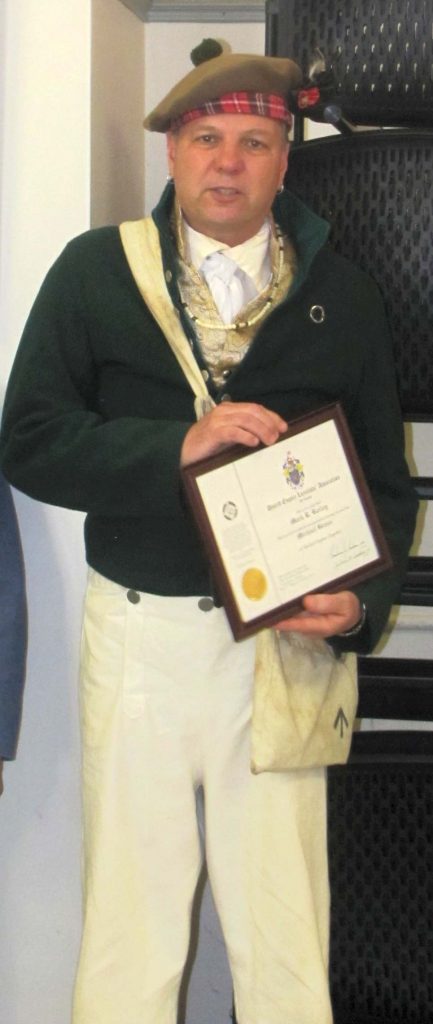
The meeting included presentation of a Loyalist Certificate to member Mark Bailey, who proved descent from Michael Grass, a Loyalist who settled in Grantham Township, Lincoln County (not to be confused with the Michael Grass who settled in Kingston Township; they were likely cousins but that is not certain). Mark chose to receive his certificate dressed as Michael’s son George Grass, who served in the War of 1812. Mark enjoys historical re-enactment and has appeared numerous times as his 1812 ancestor, as well as portraying other soldiers from other time periods.
Joyce Fingland gave a presentation “DNA: Which Test and Why?”. Joyce explained that there are several types of DNA test available:
- Y-DNA testing (done until recently only by Family Tree DNA) is only available to males, and is really only useful when wanting to determine if two known men descend from the same male, e.g. a great-great-grandfather in common. Obviously both men must take the test in order for it to work.
- MtDNA, or Mitochondrial DNA, is passed from every woman to her female descendants. It is not useful for genealogical purposes, since it would only tell you that hundreds of generations ago you had a female ancestor in, say, Europe.
- Autosomal DNA, sometimes called “Family Finder” testing, enables your DNA to be compared to that of other individuals who have taken a test with the same company, or else have added their test results to other third-party sites. This permits you to find extended family members. Joyce stated that autosomal testing offers the best starting point, and is the least expensive option. It can sometimes help solve family mysteries, or debunk myths.The “Origins” report which each testing company provides is the least accurate and useful part of the testing, despite the Ancestry ads which show a man exchanging his kilt for lederhosen: Joyce demonstrated the difference between her first Origins report from FTDNA which indicated more French-German origins than UK, and a new report after the company revised their algorithms which showed her (more correctly) with a much higher percentage of British ancestry. Even at that, the Origins Report is not what genealogists are after: they want to find relatives who share ancestry several generations back.
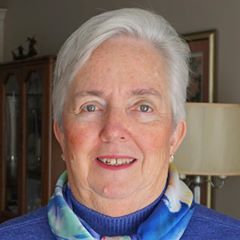 Supplied photo
Supplied photo
Joyce mentioned that there are three major companies who have been performing DNA testing for genealogical purposes for a number of years: Ancestry, FamilyTreeDNA, and 23AndMe. She outlined advantages and disadvantages of testing with each company, and also mentioned a couple of newcomers to the industry, MyHeritage and LivingDNA.
Joyce stressed the importance of putting up a family tree at the site where you test, to accompany your test results. In that way those who are found to “match” you — that is, to share portions of your DNA — can look at your pedigree chart to figure out where you match them. There is also a well-used free third-party site, GEDMatch.com, to which you can upload your raw data results from your own testing company and have them compared against those who tested with one of the other companies, thereby increasing your chances for matches.
If people wonder “why bother finding 4th or 5th cousins?”, Joyce told us that she found a match through GEDMatch to two sisters who were her 4th cousins. These ladies, who were 84 and 97 when she began to correspond with them, decided that she would be the best new guardian for the set of letters written between 1854 and 1886 by Joyce’s great-great-grandfather to his niece, their great-grandmother. What a treasure!
Wednesday, May 30, 2018
We gathered at Minos Village Restaurant for a great banquet — probably one of the last events to be held there. See photos and read about Jennifer DeBruin’s talk here. 2018_Banquet_photos_and_talk
Tuesday, June 12, 2018 – “Loyalist Day in Kingston”
The fife and drum unit from the Fort Henry Guard escorted the honour party from City Hall to the foot of the flagpole in Confederation Park. 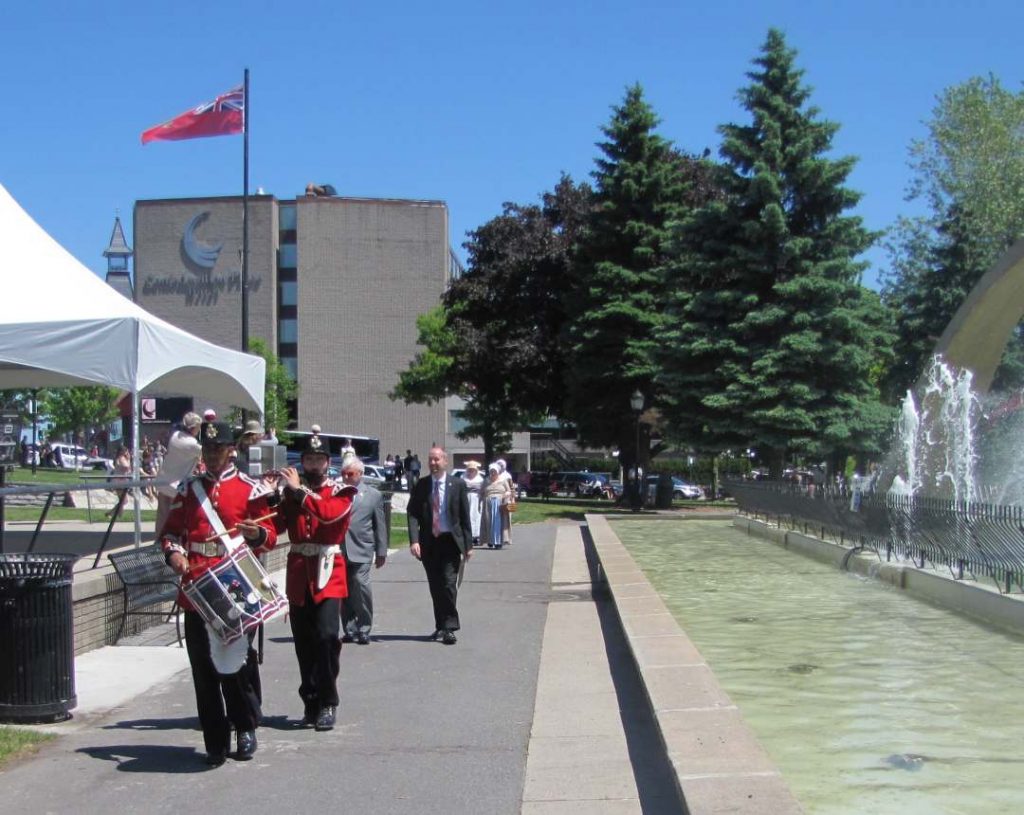
Mayor Bryan Paterson read the official Proclamation of Loyalist Day and the Loyalist flag was raised as we sang the Royal Anthem. 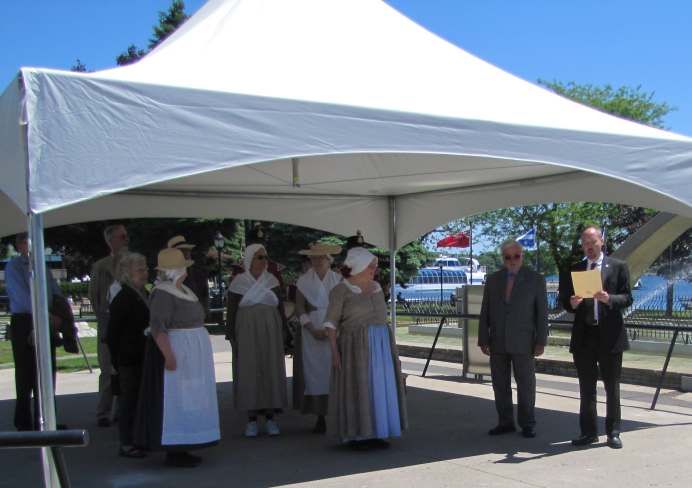
It was a lovely sunny, breezy day and the flag flew proudly for the remainder of the day, in front of the 1846 martello tower built to protect Kingston’s harbour. 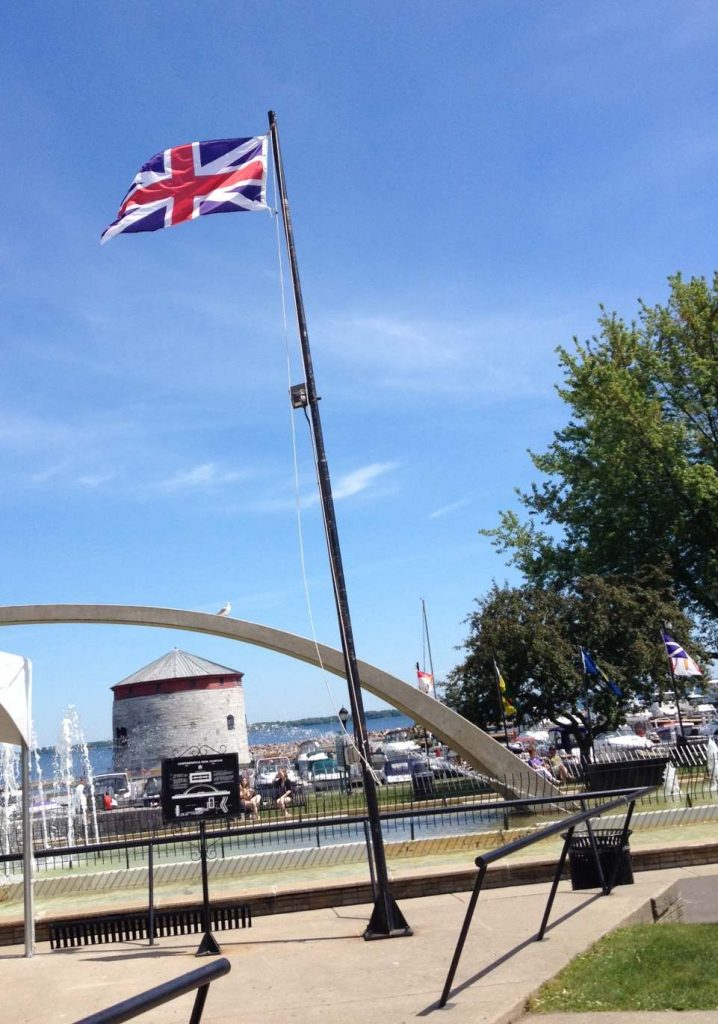
Most Loyalists attending in 21st-century clothing declined to join the group photo. We need some sewing sessions!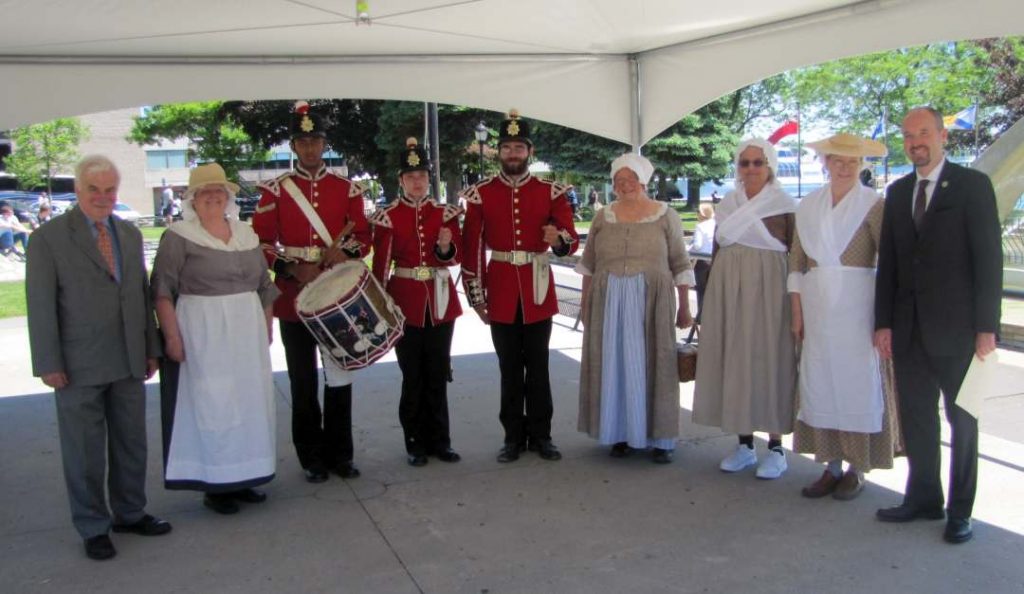
Saturday, September 22, 2018
Dr. Jay Young from the Archives of Ontario spoke to us about “Family Ties: Ontario Turns 150: Stories of four family groups in Ontario at the time of Confederation”. The Archives of Ontario’s mission is to collect, preserve, promote and make available Ontario’s documentary history. The families they selected for this exhibit were to be representative of those in Ontario in 1867, but of course they had to meet other criteria as well, including the availability within the Archives of documents and photos of them.
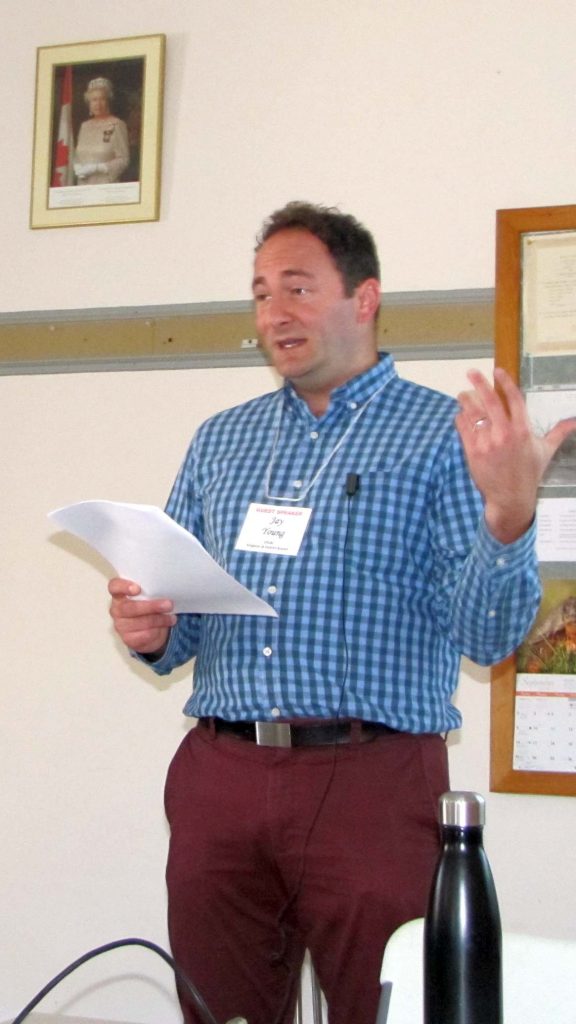
Dr. Young first discussed the family of George Brown, the publisher of the Toronto Globe newspaper. He had photos of George, his wife Anne, and their children. Brown advocated constitutional reform, wanting a federal union with two levels (as we have now) in order to break the deadlock in the United Canadas: Canada East and West each had the same number of seats. Brown wanted seats to be distributed according to population, which would give Ontario more seats than Quebec. Brown lost his run for parliament in 1867 and never sat in the House although he was later appointed to the Senate. He was murdered in 1880 at age 61 by an ex-employee. His daughters were among the first five female graduates of the University of Toronto. You can find an online exhibit about the Brown family – go to http://www.archives.gov.on.ca/en/explore/online/familyties/index.aspx.
The second family Dr. Young discussed were Nasa and Permillia McCurdy, free blacks who arrived at Amherstburg with their four children by 1856. He pointed out that for most people in rural Ontario, the only records of their activities are generally census and tax records, plus vital statistics after 1869. These can all be found through archives. The McCurdy’s great-great-grandson Howard was the second black person to serve Canada as an MP; he died earlier this year at age 85.
The Wolverton family of Oxford County could be included in this presentation because of the existence of abundant correspondence between Rose and her brother Alonzo. When the American Civil War broke out, all four of Rose’s brothers went south to fight on the Union side, including 15-year-old Newton who accompanied 20-year-old Alonzo to join up as teamsters. Newton returned home after their one-year hitch, and later joined the Oxford Rifles militia; Alonzo remained in the US and was promoted to 2nd Lieutenant. The other two brothers were killed in fighting. Rose’s letters told Alonzo about everything happening in Canada, e.g. a November 1864 letter mentioned the Quebec Conference discussing confederation. She also wrote to him while he was in Tennessee and asked for a lock of his hair so she could make it into something – perhaps not the elaborate hair wreath shown on page 1, but similar. Fortunately Alonzo brought the letters he received back home when he returned, and a descendant donated all the correspondence to the Archives. (Dr. Young pointed out that all the colours of flowers in the wreath are made from hair, even the white ones. Someone devoted great effort to create such an artifact.)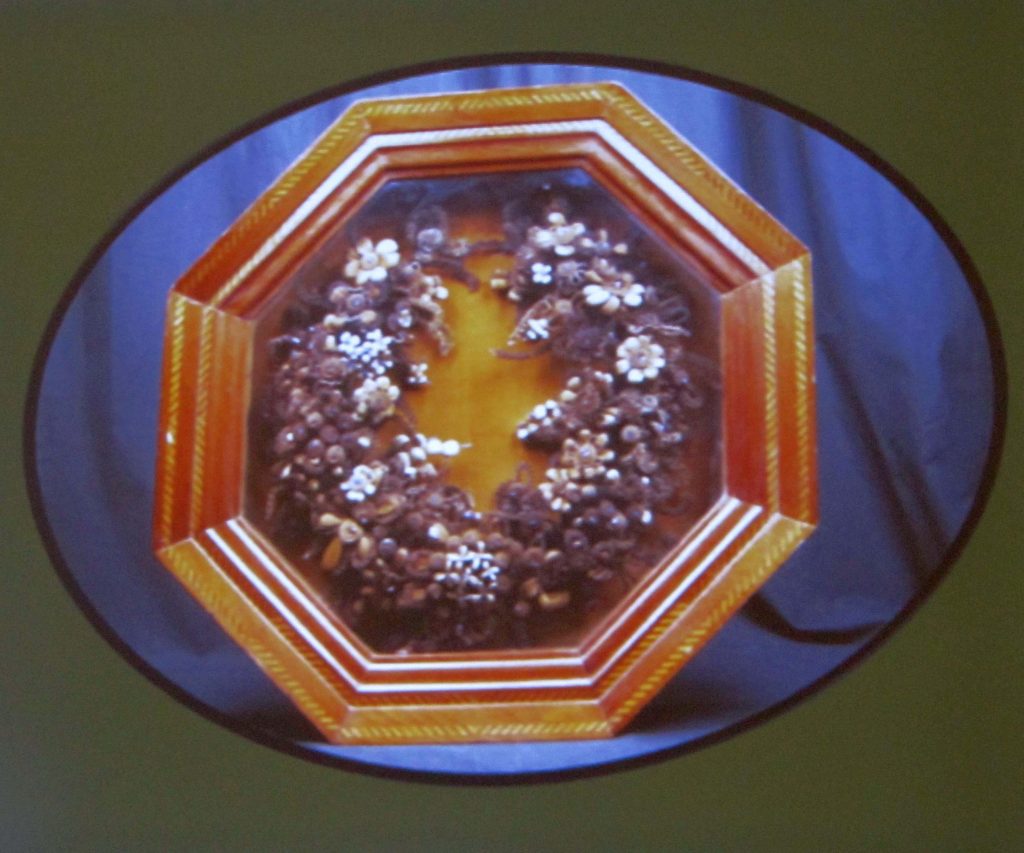
The final family group Dr. Young discussed were the families of Shingwauk. Chief Shingwauk of Garden River First Nation near Sault Ste. Marie signed the Robertson Huron Treaty in 1850, and wanted Indigenous children to be educated in both traditional knowledge and the knowledge of European settlers. A large school was erected at Sault Ste. Marie for this purpose. Chief Shingwauk had a vision of cross-cultural education, and for the first twenty years or so, native knowledge was indeed part of the curriculum. Unfortunately that vision faded, and the school became like other residential schools.
You can visit the Archives of Ontario’s website at http://www.archives.gov.on.ca/. You can also see over 100 videos about events in Ontario and items from their collection on YouTube. You’ll find the Archives of Ontario YouTube channel at https://www.youtube.com/ArchivesOfOntario.
November 24, 2018
Ruth Nicholson spoke to us about “Three Loyalist Heroes”. Robert Land is an important figure in the early settlement of Hamilton, Ontario. During the Revolutionary War he served as a courier for Colonel Clinton as well as recruiting for the Crown. He was captured once but managed to escape. He and his sons eventually owned 1,000 acres of land that now forms part of downtown Hamilton.
Ruth’s next hero was one of her ancestors: Isaac Ferriss, eldest son of Joseph Ferriss, a Loyalist ancestor on her maternal side. Isaac fought in the War of 1812 and eventually received a Military General Service Medal when they were commissioned by Queen Victoria in 1847 for those surviving claimants involved in one of the three most notable victories for the British: Battle of Fort Detroit, Battle of Chrysler Farms and Battle of Chateauguay. Ruth’s third hero, John Cornwall UEL, is her 6th-great paternal grandfather.
Ruth said in conclusion that these three men — Robert Land, Isaac Ferriss and John Cornwall — were heroes in a variety of ways, acting as a spy, a recruiter, a soldier, an escapee, a refugee and a parliamentarian. In all ways, these early residents of Upper Canada and their families helped to shape the country that we live in today.
